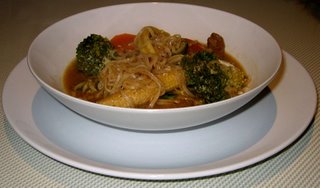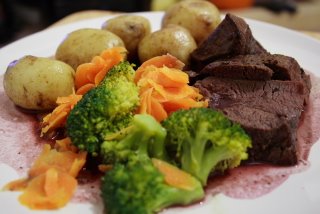I've spent most of the week clearing out the freezer. Still it's quite full. However, I think it's about time I made some nice Bulgarian bean soup. It's completely vegetarian, which is great, but Lundulph is not designed for vegetarian food, so I've added the gammon to give it more substance.

I think this is one of the most popular Bulgarian dishes and there are probably lots of variations in the different parts of Bulgaria. This is my Mum's recipe. There are two ways to make it. If you have a pressure cooker, then this comes in handy, as it shortens cooking time considerably.
Alternatively, it can be slow cooked in the oven, which makes it even tastier. My earliest memories of the soup is watching it cook on an open fire at my Grandparents' allotment. Then it was made in a terracotta pot and is definitely the tastiest way to do it. I'll describe the pressure cooker method. The recipe contains a spice mixture called
Vegeta, which I've found available in Turkish shops. It contains salt, so you can either use it or just add salt to taste (not necessarily the same amount!). Also if you are doing gammon, that's quite salty, so reduce the amount of salt in the soup.
Bulgarian Bean Soup500 g dried white beans
2 medium sized onions
2 medium sized carrots
2 - 3 green peppers
2 - 3 cloves of garlic
black pepper
2 - 3 tbsp Vegeta
3 - 4 tbsp dried savory
1 tsp sugar
1 dl olive oil
2 medium sized grated tomatoes or 1 tbsp tomato puree
1 dl fresh chopped or finely cut parsley
0.5 dl fresh finely cut spearmint
0.5 dl fresh chopped lovage
3 - 4 tbsp fresh finely cut dill
- Clean the beans and place in a large bowl and fill with water. Depending on how old the beans are and what type they are, leave them to soak for 4 h up to 2 days for very old beans. I've found that the beans I buy in the supermarket are OK with about 8-10 h soak, I fill the bowl in the morning before I go to work, then I cook them in the evening when I get home. This reduces the cooking time a bit.
- At the end of the soaking, remove any remaining water, place in the beans in the pressure cooker and add water until it reaches about 5 cm above the beans.
- Close the pressure cooker and bring to the boil and let boil under pressure for 15 - 20 minutes.
- In the mean time peel and dice the vegetables and measure up approximately the same amount of water and boil it in a kettle. It depends on how much soup you want.
- After the initial cooking, take the pressure cooker off the heat and place under cold water to cool it off quickly. When the pressure is gone, open it and remove the water. Don't skip the cooling, because it's almost impossible to open the lid otherwise and should you manage to do that, the contents will explode in your face.
- Add the new hot water, then add the vegetables and bring to the boil without the lid.
- After the soup has started boiling, add the spices and olive oil, then cover and cook under pressure for 1 - 2 h on low-medium heat, again depending on the age and type of the beans.
- When the time is up, take off the heat and place under cold water to cool it quickly.
- Open and taste a bean. If it's soft, stir in the tomato(es). Add the fresh herbs as well. The measures are quite approximate, I generally put a handful or so of each. Leave to simmer for 5 minutes. If the bean is still a bit crunchy, close and cook under pressure for a bit longer.
At this point it is ready to eat. You can use dried herbs, they should then be added along with the savory. As for the savory itself, I've rarely seen it fresh in the supermarket, so haven't had a chance to try cooking with it so far.
What my Mum does, is serve the soup in this state immediately and the next day. After that she does the following.
Bean stew3 - 4 tbsp of grapeseed oil
1 tbsp of sweet paprika
- Heat up the oil on low heat.
- Add the paprika and stir very vigorously, as it burns easily.
- Pour over the soup, stir well and bring to the boil.
This "re-juvenates" the soup and it is good for another couple of days. Of course I can't remember that ever happening in my parents' house - the soup disappears very quickly independently of original amount made. Lundulph is not as big a fan as my Dad, so I make half the amounts and it lasts quite a long time anyway.
Lately my Mum has been experimenting with slow cooking and says that the bean effect doesn't take place if you use this method. I've never had this problem with beans, so I'm not bothered, but I'll ask her for the details and add it here. Yes, the beans are still done in the pressure cooker, but there is no need to soak them in advance, but put all vegetables in together with the beans from the beginning, then close and cook on the lowest possible heat for 1 h. At this point the pressure vent should have started to make a noise indicating that pressure has built up. Now you can increase the heat to low-medium and leave for 2 to 2.5 h. The trick is to heat up the soup slowly and cook for a long time. No need to change the water. At the end, add the spices, both fresh and dry. Do the stew mix as well if you want. Then just bring it to the boil again and it's done.
My idea is to do the above in a terracotta pot in the oven on the slow cook setting overnight. I'll try this next time and add an update on how it went.
Finally the gammon.
I bought boneless piece of gammon for roasting, removed as much of the fat as I could and cut up in 1 cm thick slices and grilled for about 8 minutes on each side. Cutting it was difficult, so if you can find ready sliced gammon, I recommend it.
Lundulph thought it was OK, but would be better to cut the gammon in small pieces, fry them shortly to seal them, then cook together with the bean soup. I'll try this next time and let you know what happens. Watch this space.





